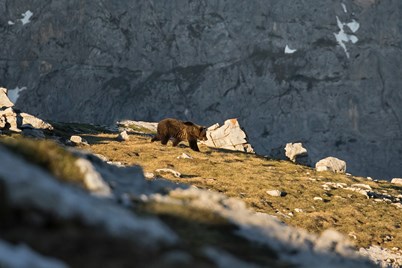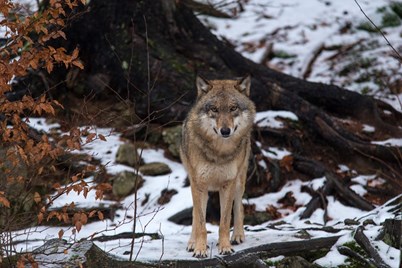The presence of bears and wolves has raised many questions about how to behave in the event of a close encounter with one of these.
We have replied to the most frequently asked questions below.
The presence of bears and wolves has raised many questions about how to behave in the event of a close encounter with one of these.
We have replied to the most frequently asked questions below.

In the late 1990s, in order to save a small nucleus of surviving brown bears from their apparently inevitable extinction, the Adamello-Brenta Nature Park along with the Autonomous Province of Trento and ISPRA (the Italian national Environmental Protection Institute) used funding from the European Union to launch the Life Ursus project. The aim was to restore a viable nucleus of bears in the Central Alps by releasing a number of individuals taken from Slovenia.
The project began in 1999, with the release of the first two bears: Masun and Kirka Between 2000 and 2002, 8 more bears were released, making a total of 10. The project, which wound up in 2004, brought the number of bears now in Trentino to over 100.
Bears are present almost exclusively in the western area of Trentino. Bears are shy animals, so it is extremely rare to encounter one.
You can learn all about how to behave in order to enjoy our forests and mountains in peace on the signposts along the trails in the areas frequented by bears, and on the Autonomous Province of Trento’s website dedicated to large carnivores www.grandicarnivori.provincia.tn.it
Bears are timid creatures, so it is unlikely that you will come across one. When bears do encounter humans, they quickly flee in most cases. In general, bears are quite indifferent to humans.
If you do happen to come across one, do not run: walk away at a normal pace.
However, it must be remembered that bears are potentially dangerous wild animals and must be treated and regarded as such. Therefore, it is essential to adopt some precautions, recommended by experts (see point 3).
You can learn all about how to behave in order to enjoy our forests and mountains in peace on the signposts along the trails in the areas frequented by bears, and on the Autonomous Province of Trento’s website dedicated to large carnivores www.grandicarnivori.provincia.tn.it
The best strategy recommended by experts is to make your presence known, for example, by talking loudly or stepping on dry branches or making other noises that warn bears of your presence. Wild animals, including bears, tend to avoid groups of people. Moreover, bears are most active during the early hours of dawn and dusk.
Never approach bear cubs, not even to observe them up close and take photos. The female bear may perceive an approach as aggressive (see point 7).
Additionally, you must never leave food or organic waste behind you, as this can attract all kinds of wild animals, not just bears. This is also a good rule for respecting the environment in general.
You can learn more about how to behave in order to enjoy our forests and mountains on the Autonomous Province of Trento’s website dedicated to large carnivores: www.grandicarnivori.provincia.tn.it/FAQ
If you have a dog with you, it is essential that you keep it on a lead so that it doesn’t approach a bear, either disturbing or attacking it, but also so that the dog doesn’t lead the bear back to you if it needs protection.
You can learn more about how to behave in order to enjoy our forests and mountains on the Autonomous Province of Trento’s website dedicated to large carnivores: www.grandicarnivori.provincia.tn.it/FAQ
If you see a bear, do not approach it and do not stay in the area, even to observe or photograph it. Slowly and silently return the way you came. Do not run. If the bear has seen you, it will probably go away on its own. Wait for it to leave before continuing, and do not follow it, even if you are in a car. If the bear follows you, slowly back away without turning your back to it. Speak firmly.
You can learn more about how to behave in order to enjoy our forests and mountains on the Autonomous Province of Trento’s website dedicated to large carnivores: www.grandicarnivori.provincia.tn.it/FAQ
In the event of a close encounter, experts recommend remaining calm, and avoiding running or making quick or agitated movements. It is important to back away slowly. If the bear stands up on its hind legs, it means that it wants to identify you to evaluate the situation. In this case, stay still and make your voice heard, calmly and without shouting.
If the bear shows signs of aggression through vocalisations, breathing or pawing the ground, back away slowly without losing sight of the animal. Do not run. If the bear runs at you aggressively, stay still. Do not shout.
In the unlikely event of physical contact that knocks you to the ground, stay with your face down, covering your neck with your hands. Do not react. If you are wearing a backpack, do not get rid of it: it could be useful for protecting yourself. Before getting back up, make sure that the animal has gone away.
As soon as possible, report the event to the relevant authorities.
You can learn more about how to behave in order to enjoy our forests and mountains on the Autonomous Province of Trento’s website dedicated to large carnivores: www.grandicarnivori.provincia.tn.it/FAQ
A female with cubs may consider a person who is very close a threat to her cubs, particularly in the event of a surprise encounter at close quarters.
To prevent/limit this, we recommend that you follow the advice in point 6.
You can learn more about how to behave in order to enjoy our forests and mountains on the Autonomous Province of Trento’s website dedicated to large carnivores: www.grandicarnivori.provincia.tn.it/FAQ
The dangerousness of the bear can manifest itself in particular conditions. In addition to the case of a female with cubs, mentioned above, injured bears, bears surprised while feeding on a carcass or other food, bears suddenly startled, frightened, bears disturbed in their dens and, generally, bears that are very confident around humans.
www.grandicarnivori.provincia.tn.it/Quando-l-orso-puo-essere-pericoloso
You can learn more about how to behave in order to enjoy our forests and mountains on the Autonomous Province of Trento’s website dedicated to large carnivores: www.grandicarnivori.provincia.tn.it/FAQ
If you notice the presence of a bear in inhabited areas or close to human activities:
You can learn more about how to behave in order to enjoy our forests and mountains on the Autonomous Province of Trento’s website dedicated to large carnivores: https://grandicarnivori.provincia.tn.it/Comunicazione/FAQ

Trentino is home to other large carnivores in addition to bears, such as wolves (present throughout Italy, with a thriving population of over 3,000 individuals) and lynxes, though there are only rare examples of the latter.
In the majority of cases of encounters with humans, wolves will retreat without showing any signs of aggression. This is true both for lone wolves and for animals belonging to a family group, known as a “pack”, which usually consists of a couple and their offspring. At other times, they may demonstrate an indifferent attitude.
Despite this, it is wise to abide by certain basic precautions.
As explained above, the chances of meeting a wolf are remote; in the event that you do encounter one, in most cases the wolf is likely to retreat without displaying any aggressive behaviour. This is true both for lone wolves and for animals belonging to a family group/pack.
You can learn more about how to behave in order to enjoy our forests and mountains on the Autonomous Province of Trento’s website dedicated to large carnivores:https://grandicarnivori.provincia.tn.it/Comunicazione/FAQ
You can find more information at LIFE WolfAlps EU project: https://www.lifewolfalps.eu/en/wolf-faq/
To minimise your already slim chances of encountering a wolf at close quarters, you can make noise — for example, by speaking loudly. In the event of a close encounter, keep calm and distance yourself without running. After the wolf has moved away, do not follow it and avoid interfering with its behaviour in all cases. Following the animals in any way is forbidden, even in cases where they are spotted from the car.
If, on the other hand, you have seen the wolf from a distance, stay still and keep silent in order to allow the wolf to continue along its path.
You can learn more about how to behave in order to enjoy our forests and mountains on the Autonomous Province of Trento’s website dedicated to large carnivores: https://grandicarnivori.provincia.tn.it/Comunicazione/FAQ
You can find more information at LIFE WolfAlps EU project: https://www.lifewolfalps.eu/en/wolf-faq/
If you have a dog with you, it is best to keep it on a leash to prevent it from running away and inadvertently approaching a wolf which may see it as prey. Not only do the regulations prohibit dogs from roaming the woods freely, in order to protect the wildlife, but they may also be preyed upon by wolves.
You can learn more about how to behave in order to enjoy our forests and mountains on the Autonomous Province of Trento’s website dedicated to large carnivores:https://grandicarnivori.provincia.tn.it/Comunicazione/FAQ
You can find more information at LIFE WolfAlps EU project: https://www.lifewolfalps.eu/en/wolf-faq/
Do not leave any organic waste behind you, either in the woods or close to inhabited areas, as wolves may be attracted by this source of food. This risks them gradually losing their natural wariness of human beings. This would be an extremely negative development, primarily for humans but also for the wolves themselves.
You can learn more about how to behave in order to enjoy our forests and mountains on the Autonomous Province of Trento’s website dedicated to large carnivores:https://grandicarnivori.provincia.tn.it/Comunicazione/FAQ
You can find more information at LIFE WolfAlps EU project: https://www.lifewolfalps.eu/en/wolf-faq/
Claudio Groff (Coordinator of Large Carnivore sector of the Autonomous Province of Trento) discusses bears, wolves and lynxes in Trentino, and how to behave in areas where these animals are present.